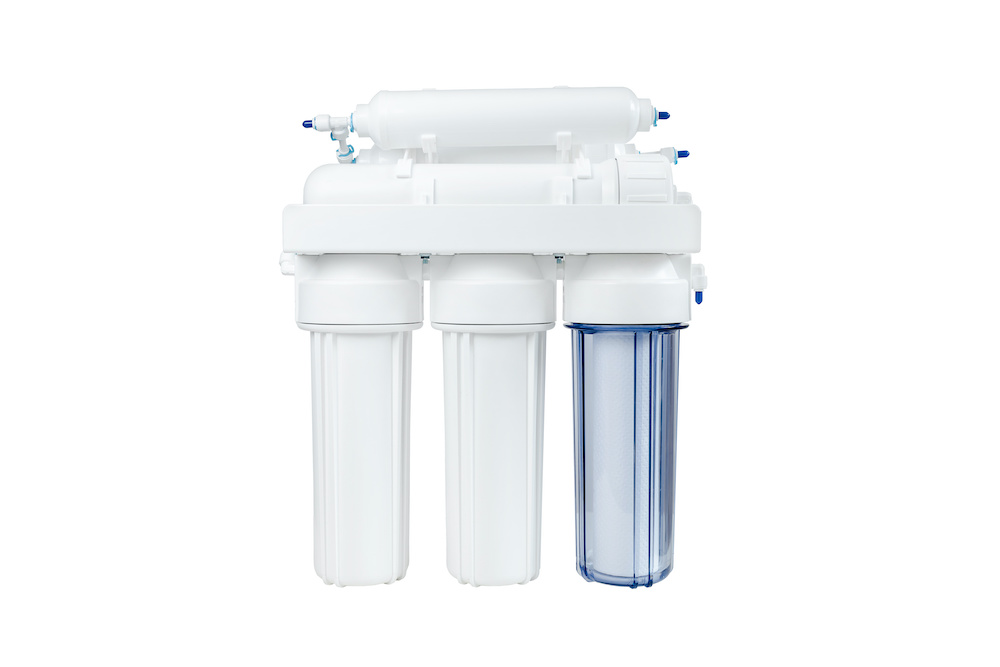“Does reverse osmosis remove PFAS (Perfluoroalkyl and Polyfluoroalkyl Substances)?” is one of the most common questions today because of the growing health concerns during the past decade.
Not only has it been shown to take a long time to get removed from the body, but recent studies have shown that it poses multiple health risks.
Fortunately, yes, you can remove PFAs in your drinking water using reverse osmosis (RO).
That’s because it’s a treatment process that uses a semi-permeable membrane to remove up to 99% of water contaminants.
But how does it do that? Let’s discuss this below.
We’ll also explain what PFAS are, why you should avoid them, and other ways to filter them out from your water.
What Is PFAS?
To fully understand how reverse osmosis systems remove PFAS, let’s first discuss what PFAS is and why it should be filtered out from drinking water.
As mentioned, PFAS is a group of human-made chemicals created in the 1940s and currently classified by the thousands and used for various purposes.
However, they’re mainly used as water and grease repellants, thanks to their ability to withstand extreme environmental scenarios.
They’re so ubiquitous that if you have anything that’s non-stick or water-resistant, chances are it has PFAS in it.
In fact, according to the CDC, nearly all US citizens have PFAS in their bloodstream.
Given how useful and ubiquitous PFAS chemicals are, when do they become a problem?
Well, they’re not called “forever chemicals” for no reason. PFAS chemicals take up to 56 years to dissolve in your bloodstream.
Studies have also shown that they can cause infertility, increased cholesterol, compromised immune systems, and hampered child development.
With these, scientists called to lower the standard as to what acceptable PFAS levels should be.
In 2009, 0.2 micrograms were the generally considered safe level for PFAS. In 2016, they suggested lowering it to 0.07 micrograms, especially in water treatment facilities over the US.
However, as of 2022, facilities that fail to enforce this won’t be penalized due to a lack of federal laws.
Still, this doesn’t discount the fact that higher PFAS levels are detrimental to your health.
How Do Reverse Osmosis Systems Remove PFAS?
To understand how does reverse osmosis remove PFAS in drinking water, let’s first talk about how reverse osmosis work.
Essentially, reverse osmosis simply imitates a naturally occurring process called osmosis, albeit backward.
Osmosis is a molecular attraction that causes a low-concentrated solution moves toward a high-concentrated solution.
To give you a better example, imagine having two tanks separated by a semi permeable membrane (a filter that only allows water to pass through): one full of saltwater and the other full of fresh water.
The freshwater will inevitably get pulled toward the saltwater thanks to the latter’s high sodium ion concentration.
Other examples of natural osmosis include water absorption by human kidneys from the blood and plant roots from the earth.
RO systems use pressure to reverse the process of osmosis.
The pressurized water flows through the membrane, leaving behind the bacteria, PFAS, minerals, sediments, and other contaminants.
It can also remove from water the otherwise chemically bonded phosphorous, fluoride, radium, potassium, calcium, sulfate, magnesium, nitrate, and arsenic.
Now you know how reverse osmosis works as a chemical process, let’s walk through the technical process.

The Three-Stage Reverse Osmosis Process
Three-stage RO systems typically have a polypropylene sediment filter, carbon filter, and semi-permeable membrane.
First, the source water passes through the sediment filter, the initial purification stage in the system.
It helps improve the taste and appearance of your water by removing sediment and bigger particles such as rust, grit, and silt.
We recommend that you choose sediment filters that are rated 50 microns or below to filter sediments properly.
Not only will these filters help keep you safer from harmful bacteria. They will also protect your activated carbon filter from larger contaminants that can otherwise get stuck.
Next, the pre-filtered water goes to the second stage, the activated carbon filter.
This stage uses granulated activated carbon (GAC) to condition the water and remove chlorine and chloramines before the last filtering stage.
Not only does it remove poor taste and odor such as hydrogen sulfide, but it also serves as the first layer of filtration for PFAS chemicals.
Lastly, it goes through the semi-permeable membrane, which removes the remaining PFAS chemicals thanks to its ion filtration of up to 0.0001 microns.
Things to Remember When Using RO Systems for PFAS Removal
To ensure your RO systems remain as effective as they’re designed to remove PFAS and other contaminants, you need to do the following:
Follow the Proper Maintenance Schedule
Maintenance schedules exist for a reason. In some cases, an unmaintained RO system can be more dangerous than unfiltered water.
That is because water filters tend to retain some contaminants every time they clean your water.
Using filters beyond their advised lifespan can cause them to become oversaturated and introduce previously filtered contaminants to the source water.
Also, their filtering capabilities become compromised over time
Different filter brands have varying schedules for changing, so read their packaging before use.
You can also discard the cartridges in advance if you notice discoloration or a change in water taste or smell.
Check if Your RO System Works for PFAS
High PFAS levels in your drinking water can be concerning, so the EPA designed three methods (Method 537, 537.1, and 533) to test your water levels in a laboratory setting.
Unfortunately, PFAS testing can be expensive, and only select labs offer EPA Method 537.
Testing kits can also cost up to $262, depending on your state, lab, and compounds included.
Experts also advise that you check your water source for PFAS every ten years, especially if they come from a water well.
If you followed these recommendations, you would be well into the cost of an RO system. Therefore, it is a good idea just to get an RO, which will filter PFAS as well as many other contaminants.
Lastly, note that if you just want peace of mind regarding your PFAS levels, it’s important to have it checked before and after installing your selected water treatment system.
This is so you can check whether or not your installed system is effective.
What Are Other Ways to Remove PFAS?
Aside from RO systems, here are other approved water treatment systems that can effectively remove PFAS:
Ion Exchange Resins
Ion exchange resins also work well in removing PFAS. They are polymer beads or granules coated with either positively-charged sodium ions or negatively-charged chloride ions.
Resins coated with positively charged ions attract negatively charged contaminants such as the hard minerals calcium or magnesium.
This is what you see with water softeners.
On the other hand, resins coated with negatively charged chloride ions attract positively charged contaminants such as arsenic and most PFAS chemicals.
This variant of ion exchange resins is what you want if you specifically want to filter PFAS contaminants.
Activated Carbon Filters
Another effective way of removing PFAS from your water source is through activated carbon filters.
Carbon filters use a chemical process called adsorption (not absorption).
Adsorption happens when an adsorbent (in this case, the activated carbon) binds atoms, ions, or molecules from adsorbates (liquid, gas, or dissolved solid contaminants, i.e. PFAS chemicals).
However, activated carbon filters typically only remove select contaminants from your water.
For example, while it can filter out chlorine and PFAS chemicals, it can’t efficiently filter out iron or nitrate particles.
Does Reverse Osmosis Remove PFAS: In Conclusion
RO does remove PFAS, and it does so efficiently. Thus, you can consider having one installed if you want to lessen your PFAS intake.
Just remember that it’s important to follow the proper maintenance schedule for your RO system.
Also, consider testing your water with the Method 537.1 test.

